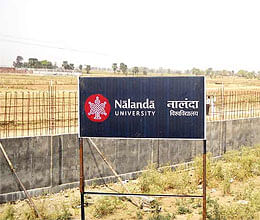
Part of a premier state-owned hotel will temporarily serve as a hostel for students of the revived Nalanda University, an international centre of learning coming up in Bihar, in eastern India, that will open its doors on September 1. More than 1,000 students from 40 countries have sought admission in Nalanda University.
Applications have come from the US, Russia, England, Spain, Germany, Japan, Myanmar, Austria and Sri Lanka, as also from West Asian and Southeast Asian countries among others.
Forty students or Nalanda Fellows have be admitted to the School of Historical Sciences and School of Environment and Ecology with which the university will initially start functioning at the Buddhist pilgrim town of Rajgir, about 100 km from state capital Patna, where the sprawling university is set to come up.
"About 40 students from different countries enrolled in two schools of Nalanda university will be provided hostel accommodation in Hotel Tathagat," which is owned by the Bihar State Tourism Development Corporation (BSTDC), a university official told IANS from Rajgir.
"The hotel, which is spread over three acre land near a hot springs site, has lush green surroundings. Part of it will function as a hostel for two to five years," the official added.
The university will pay over Rs.1 crore ($166,000) per annum to the BSTDC for the facility.
"It will be comfortable for students because classes would be held at the nearby convention hall of the state government," the official added.
Rajgir attracts thousands of tourists from all over the world every year. It is the second-most visited tourist place in the Buddhist circuit in Bihar after Bodh Gaya, considered the birthplace of Buddhism, where Gautam Buddha attained enlightenment over 2,500 years ago. Rajgir (then Rajagriha) was the first capital of the Magadha kingdom and one of the favourite places of the Buddha.
Six faculty members have been appointed for each of the two schools. They are from New Zealand, England, the US and Singapore, among others.
The university will be fully residential, like the ancient Nalanda university. It will offer courses in science, philosophy and spirituality as well as social sciences.
The university, an initiative of the Indian government and the 18 East Asia Summit (EAS) countries, is coming up at Rajgir around 12 km from the ruins of its ancient namesake that was flocked by thousands of scholars and thinkers from across the world till the 12th century. It was destroyed by the invading Turkish army of Bakhtiyar Khilji, a general of Qutbuddin Aibak. It was set on fire by the invaders and the blaze in the huge library is believed to have raged for several days.
An around eight-kilometre boundary wall marks the 446-acre campus where the modern centre of excellence is to come up.
The residential university, due to be completed by 2020, is to have seven schools - all for postgraduate and doctorate students.
Last May the Nalanda board had approved the architectural plan of the proposed university.
The department of expenditure has cleared the Rs.2,700 crore cost for the university to be spent over 10 years.
The architectural design approved for the new university has proposed a massive lake at the centre of the campus. The library, a huge dome-shaped structure, would come up in the middle of the lake and be half submerged.
China has already committed $1 million for the project, Singapore has pledged $5-6 million and Australia about $1 million Australian dollars. All the funds have been committed on a voluntary basis.
During his trip to Brunei last October, Manmohan Singh, the then prime minister, had inked agreements with seven EAS countries that have pledged their commitment to the Nalanda University project. The memorandums of understanding (MoUs) were signed with Australia, Cambodia, Singapore, Brunei, New Zealand, Laos and Myanmar. India signed the Mou with China during the prime minster's visit to Beijing last November.
Applications have come from the US, Russia, England, Spain, Germany, Japan, Myanmar, Austria and Sri Lanka, as also from West Asian and Southeast Asian countries among others.
Forty students or Nalanda Fellows have be admitted to the School of Historical Sciences and School of Environment and Ecology with which the university will initially start functioning at the Buddhist pilgrim town of Rajgir, about 100 km from state capital Patna, where the sprawling university is set to come up.
"About 40 students from different countries enrolled in two schools of Nalanda university will be provided hostel accommodation in Hotel Tathagat," which is owned by the Bihar State Tourism Development Corporation (BSTDC), a university official told IANS from Rajgir.
"The hotel, which is spread over three acre land near a hot springs site, has lush green surroundings. Part of it will function as a hostel for two to five years," the official added.
The university will pay over Rs.1 crore ($166,000) per annum to the BSTDC for the facility.
"It will be comfortable for students because classes would be held at the nearby convention hall of the state government," the official added.
Rajgir attracts thousands of tourists from all over the world every year. It is the second-most visited tourist place in the Buddhist circuit in Bihar after Bodh Gaya, considered the birthplace of Buddhism, where Gautam Buddha attained enlightenment over 2,500 years ago. Rajgir (then Rajagriha) was the first capital of the Magadha kingdom and one of the favourite places of the Buddha.
Six faculty members have been appointed for each of the two schools. They are from New Zealand, England, the US and Singapore, among others.
The university will be fully residential, like the ancient Nalanda university. It will offer courses in science, philosophy and spirituality as well as social sciences.
The university, an initiative of the Indian government and the 18 East Asia Summit (EAS) countries, is coming up at Rajgir around 12 km from the ruins of its ancient namesake that was flocked by thousands of scholars and thinkers from across the world till the 12th century. It was destroyed by the invading Turkish army of Bakhtiyar Khilji, a general of Qutbuddin Aibak. It was set on fire by the invaders and the blaze in the huge library is believed to have raged for several days.
An around eight-kilometre boundary wall marks the 446-acre campus where the modern centre of excellence is to come up.
The residential university, due to be completed by 2020, is to have seven schools - all for postgraduate and doctorate students.
Last May the Nalanda board had approved the architectural plan of the proposed university.
The department of expenditure has cleared the Rs.2,700 crore cost for the university to be spent over 10 years.
The architectural design approved for the new university has proposed a massive lake at the centre of the campus. The library, a huge dome-shaped structure, would come up in the middle of the lake and be half submerged.
China has already committed $1 million for the project, Singapore has pledged $5-6 million and Australia about $1 million Australian dollars. All the funds have been committed on a voluntary basis.
During his trip to Brunei last October, Manmohan Singh, the then prime minister, had inked agreements with seven EAS countries that have pledged their commitment to the Nalanda University project. The memorandums of understanding (MoUs) were signed with Australia, Cambodia, Singapore, Brunei, New Zealand, Laos and Myanmar. India signed the Mou with China during the prime minster's visit to Beijing last November.








